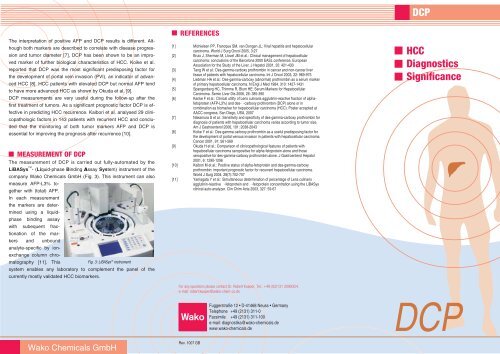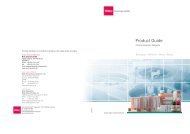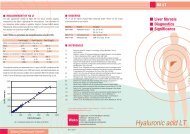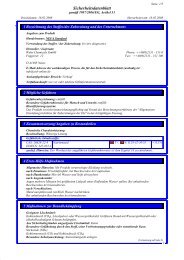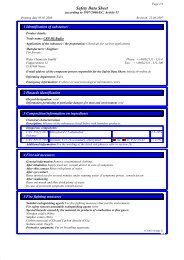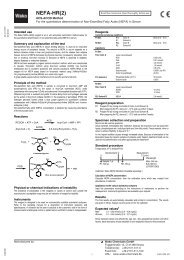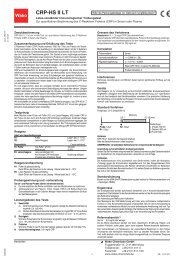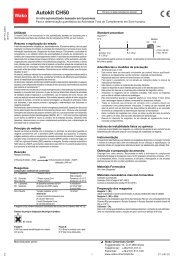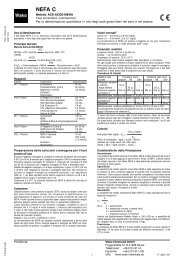DCP Flyer deutsch Wako chemicals - Wako Chemicals GmbH
DCP Flyer deutsch Wako chemicals - Wako Chemicals GmbH
DCP Flyer deutsch Wako chemicals - Wako Chemicals GmbH
You also want an ePaper? Increase the reach of your titles
YUMPU automatically turns print PDFs into web optimized ePapers that Google loves.
The interpretation of positive AFP and <strong>DCP</strong> results is different. Although<br />
both markers are described to correlate with disease progression<br />
and tumor diameter [7], <strong>DCP</strong> has been shown to be an improved<br />
marker of further biological characteristics of HCC. Koike et al.<br />
reported that <strong>DCP</strong> was the most significant predisposing factor for<br />
the development of portal vein invasion (PVI), an indicator of advanced<br />
HCC [8]. HCC patients with elevated <strong>DCP</strong> but normal AFP tend<br />
to have more advanced HCC as shown by Okuda et al. [9].<br />
<strong>DCP</strong> measurements are very useful during the follow-up after the<br />
first treatment of tumors. As a significant prognostic factor <strong>DCP</strong> is effective<br />
in predicting HCC recurrence. Kaibori et al. analysed 29 clinicopathologic<br />
factors in 143 patients with recurrent HCC and concluded<br />
that the monitoring of both tumor markers AFP and <strong>DCP</strong> is<br />
essential for improving the prognosis after recurrence [10].<br />
MEASUREMENT OF <strong>DCP</strong><br />
The measurement of <strong>DCP</strong> is carried out fully-automated by the<br />
LiBASys TM<br />
- (Liquid-phase Binding Assay System) instrument of the<br />
company <strong>Wako</strong> <strong>Chemicals</strong> <strong>GmbH</strong> (Fig. 3). This instrument can also<br />
measure AFP-L3% together<br />
with (total) AFP.<br />
In each measurement<br />
the markers are determined<br />
using a liquidphase<br />
binding assay<br />
with subequent fractionation<br />
of the markers<br />
and unbound<br />
analyte-specific by ionexchange<br />
column chromatography<br />
[11]. This<br />
Fig. 3: LiBASys<br />
system enables any laboratory to complement the panel of the<br />
currently mostly validated HCC biomarkers.<br />
TM instrument<br />
REFERENCES<br />
[1] Michielsen PP, Francque SM, van Dongen JL: Viral hepatitis and hepatocellular<br />
carcinoma. World J Surg Oncol 2005, 3:27<br />
[2] Bruix J, Sherman M, Llovet JM et al.: Clinical management of hepatocellular<br />
carcinoma: conclusions of the Barcelona 2000 EASL conference. European<br />
Association for the Study of the Liver. J Hepatol 2001, 35: 421-430<br />
[3] Tang W et al.: Des-gamma-carboxy prothrombin in cancer and non-cancer liver<br />
tissue of patients with hepatocellular carcinoma. Int J Oncol 2003, 22: 969-975<br />
[4] Liebman HA et al.: Des-gamma-carboxy (abnormal) prothrombin as a serum marker<br />
of primary hepatocellular carcinoma. N Engl J Med 1984, 310: 1427-1431<br />
[5] Spangenberg HC, Thimme R, Blum HE: Serum Markers for Hepatocellular<br />
Carcinoma. Semin Liver Dis 2006, 26: 385-390<br />
[6] Kanke F et al.: Clinical utility of Lens culinaris agglutinin-reactive fraction of alphafetoprotein<br />
(AFP-L3%) and des- -carboxy prothrombin (<strong>DCP</strong>) alone or in<br />
combination as biomarker for hepatocellular carcinoma (HCC). Poster accepted at<br />
AACC congress, San Diego, USA, 2007<br />
[7] Nakamura S et al.: Sensitivity and specificity of des-gamma-carboxy prothrombin for<br />
diagnosis of patients with hepatocellular carcinoma varies according to tumor size.<br />
Am J Gastroenterol 2006, 101: 2038-2043<br />
[8] Koike Y et al.: Des-gamma carboxy prothrombin as a useful predisposing factor for<br />
the development of portal venous invasion in patients with hepatocellular carcinoma.<br />
Cancer 2001, 91: 561-569<br />
[9] Okuda H et al.: Comparison of clinicopathological features of patients with<br />
hepatocellular carcinoma seropositive for alpha-fetoprotein alone and those<br />
seropositive for des-gamma-carboxy prothrombin alone. J Gastroenterol Hepatol<br />
2001, 6: 1290-1296<br />
[10] Kaibori M et al.: Positive status of alpha-fetoprotein and des-gamma-carboxy<br />
prothrombin: important prognostic factor for recurrent hepatocellular carcinoma.<br />
World J Surg 2004, 28(7):702-707<br />
[11] Yamagata Y et al.: Simultaneous determination of percentage of Lens culinaris<br />
agglutinin-reactive -fetoprotein and -fetoprotein concentration using the LiBASys<br />
clinical auto-analyzer. Clin Chim Acta 2003, 327: 59-67<br />
For any questions please contact Dr. Robert Kueper, Tel.: +49 (0)2131 2099354,<br />
e-mail: robert.kueper@wako-chem-co.de<br />
Rev. 1007 GB<br />
Fuggerstraße 12 • D-41468 Neuss • Germany<br />
Telephone +49 (2131) 311-0<br />
Facsimile +49 (2131) 311-100<br />
e-mail: diagnostika@wako-<strong>chemicals</strong>.de<br />
www.wako-<strong>chemicals</strong>.de<br />
<strong>DCP</strong><br />
HCC<br />
Diagnostics<br />
Significance<br />
<strong>DCP</strong>
HEPATOCELLULAR CARCINOMA<br />
Hepatocellular Carcinoma (HCC) ranks globally among one of the five<br />
most common carcinomas of males. It is the most important type of liver<br />
cancer, because it represents at least 80% of the primary malignant liver<br />
tumors in adults. Europe is regarded to be a geographic area of low incidence<br />
in Northern and Western parts and medium incidence in Southern<br />
and Eastern regions, where age-adjusted incidence rates of about 10<br />
per 100.000 in men are reported [1].<br />
Most studies show an alarming increase of the mortality rate of to HCC<br />
in the recent years. Presently in Europe about 30.000 persons are dying<br />
annually due to HCC. The most important risk factors for the development<br />
of HCC are chronic liver diseases caused by viral hepatitis B and C<br />
and alcohol abuse, while the significance of each individual factor differs<br />
from country to country. Haemochromatosis, primary biliary cirrhosis and<br />
autoimmune hepatitis also increase the risk of HCC development.<br />
SCREENING AND DIAGNOSTICS<br />
Unfortunately the diagnosis of HCC mostly occurs in advanced stages<br />
of cancer, so that curative treatments are mostly not possible. In Europe<br />
more than 80 % of HCC cases develop on the background of a cirrhotic<br />
liver. Cirrhotic patients are therefore regarded to be patients of<br />
high risk. In practice they undergo surveillance programs with abdominal<br />
ultrasound investigations and determinations of -fetoprotein (AFP)<br />
twice per year. The rationale for surveillance is to detect HCC at an early<br />
stage to allow curative treatments. After detection of suspicious lesions<br />
during surveillance more sophisticated imaging techniques are<br />
available to diagnose HCC.<br />
The serum marker AFP is the only routinely used HCC marker, but its<br />
clinical significance is limited. Both the sensitivity and the specificity<br />
are low [2]. Particularly in the „grey zone“ between 10 and 200 ng/ml<br />
AFP many investigated patients don’t have a HCC, so that the decision<br />
to use further diagnostic options is difficult. Furthermore about one<br />
third of HCC patients don’t show diagnostic relevant elevations of the<br />
AFP concentration. A generally accepted diagnostic cut-off for this tumor<br />
marker doesn’t exist.<br />
WHAT IS <strong>DCP</strong>?<br />
Des-gamma-carboxy prothrombin (<strong>DCP</strong>) is an immature form of the<br />
coagulation protein, prothrombin. In the normal metabolism the<br />
prothrombin precursor undergoes a vitamin K dependent carboxylation<br />
of 10 glutamic-acid residues at the N-terminus to yield the native<br />
prothrombin. In the case of HCC this transformation is impaired by abnormalities<br />
in prothrombin precursors, reduced carboxylase activity,<br />
shortage or increased demand of vitamin K [3], which results in an accumulation<br />
of <strong>DCP</strong> (Fig 1). <strong>DCP</strong> is also known as protein induced by<br />
vitamin K absence or antagonist II (PIVKA-II).<br />
Fig. 1: Schematic figure of <strong>DCP</strong> accumulation during HCC<br />
In 1984, Liebman et al. reported for the first time that <strong>DCP</strong> is a promising<br />
biomarker for HCC [4]. In Japan <strong>DCP</strong> has been routinely used for<br />
many years as tumor marker for HCC. Since early 2007 <strong>DCP</strong> is FDA<br />
approved in the USA for the risk assessment of HCC. Since mid of<br />
2007 this product is also CE-marked for the European market.<br />
<strong>DCP</strong><br />
CLINICAL SIGNIFICANCE OF <strong>DCP</strong><br />
<strong>DCP</strong> is elevated in up to 60% of HCC patients. In many reports sens-<br />
itivities between 28 und 89% and specificities between 87% and<br />
96% were reported [5].<br />
Recently a multicenter, prospective study has been performed in the<br />
USA and Canada. Out of 372 investigated patients 40 had HCV-related<br />
HCC at entry and 332 patients with HCV related cirrhosis were<br />
followed up for up to 2 years. Of the latter group 34 patients developed<br />
HCC. As can be seen in table 1 in this study <strong>DCP</strong> showed a<br />
much higher specificity and positive predictive value than AFP for<br />
the detection of HCC [6].<br />
Table 1: Diagnostic parameters of <strong>DCP</strong> versus AFP<br />
AFP <strong>DCP</strong><br />
Cut-off 20 ng/ml 7,5 ng/ml<br />
Sensitivity 61 % 39 %<br />
Specificity 71 % 90 %<br />
Positive predictive value 34 % 48 %<br />
Negative predictive vaule 88 % 86 %<br />
It is well known that there is no correlation between AFP and <strong>DCP</strong>.<br />
The combination of both tests is therefore reasonable to improve the<br />
accuracy of HCC diagnostics. In the above mentioned study an increased<br />
overall sensitivity could be demonstrated (Fig. 2).<br />
<strong>DCP</strong>>7,5 ng/ml<br />
7 (9,5%)<br />
All negative 22 (29,7%)<br />
22 (29,7%)<br />
AFP>20 ng/ml<br />
23 (31,1%)<br />
Fig. 2: Positive patient number of <strong>DCP</strong> and AFP in patients with HCC (n=74)


